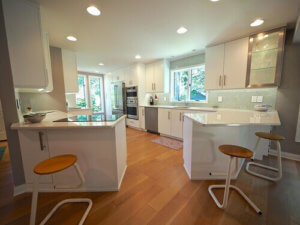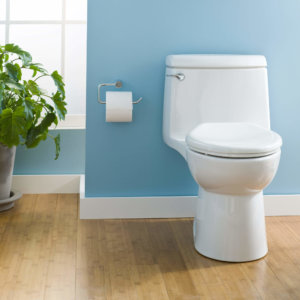How To Put Together a Remodel Budget
Starting a home remodel is exciting, yet often daunting at the same time. Whether you’re planning on a whole house remodel or want to upgrade a specific room, one of the first steps you’ll need to take is to sit down and put together a realistic budget. Another factor to consider — are you remodeling the home for personal preferences or to upgrade and modernize it for resale? Either way, take the time to work with a designer and set your budget ahead of the remodel.
What Can I Expect to Pay for a Home Remodel?

A general rule of thumb when trying to figure out a remodel budget is to spend between 5% to10% of the home’s value. Of course, depending on your needs and home remodeling goals, you can always go under or over that amount. Others say that a remodel should cost about $10 to $60 per square foot, again, depending on the room and the scope of the remodel.
Making a list of your remodeling priorities, room by room, can help you determine an approximate budget for your remodel project. Once you have researched the types of fixtures, appliances, cabinets, vanities, and windows per room, you can begin to prioritize what you want for each project. Most homeowners generally want to remodel the bathroom and kitchen first or as a priority, so make your budget for these rooms and then go for the other areas of the home you wish to remodel.
How Should I Finance My Home Remodel?
Financing your remodel shouldn’t put you in debt or break the bank. If you can finance the project with savings, go that route. However, when remodel costs begin to add up, consider financing the project. You can speak with your bank to determine the best type of loan for your needs.
A common type of home improvement or remodel loan is a home equity line of credit. Your home’s existing equity secures this loan, and you can usually get a lower interest rate than just a general loan. In addition, any interest incurred from the home equity line of credit is deductible on your taxes. When determining how much of a loan you need, it’s a good idea to put aside some cushion money in case of unforeseen work.
What Steps Should I Take to Determine My Budget?
If you feel overwhelmed about where to start with a home remodel budget, follow these steps to help you navigate through the process.
-
Prioritize Projects
Any easy way to start your remodel budget is to prioritize the projects and break each remodel idea into wants and needs. If planning a kitchen or bathroom remodel, decide if you want new appliances and fixtures, cabinets, flooring, and lighting. Figure the approximate costs of that project and start reducing items over budget. For instance, instead of getting new cabinets, maybe you can get the existing ones resurfaced or painted so you can pay for the stove, refrigerator, or dishwasher of your dreams.
-
Consider Working With a Designer or Architect
While you have to add money to your budget to hire a designer, in the long run, a designer or architect can help you get just what you want for your remodel projects. Designers can help you either totally remodel the room or make suggestions and plans on how to improve the room while staying on budget.
-
Determine Approximate Remodel Costs
Once you’ve prioritized your remodel projects, do some research so you can figure out how much each room will cost, and then you can ask your contractor to start with the most important projects first.
- Kitchen: On average, a homeowner will spend between $15,000 to $75,000 for a kitchen. This can include new cabinets, plumbing, appliances, faucets, fixtures, lights, painting, and flooring.
- Bathroom: The average cost for a bathroom remodel runs between $10,000 and up to $25,000, which can include a sink, toilet, bathtub, new fixtures, faucets, lights, windows, a vanity, and flooring.
- Dining room and living room: Depending on the size, a dining room and living room remodel, which can include structural changes, painting, flooring, and window treatments, can run between $5,000 and $20,000.
- Bedrooms: Bedroom remodels can cost between $5,000 and $10,000, including flooring, windows and treatments, lighting, and painting.
- Get Contractor Bids
Once you’ve estimated your costs, have a blueprint designed, and have sound financing for your remodel project, you’ll want to get bids from several contractors. Remember that you’ll want to vet any contractor by asking for references, licenses, and a past track record. The cheapest contractor isn’t always the best or most reliable one. Once you’ve found a bid you’re comfortable with, request the bid in writing.
How Can I Save Money on My Remodel?
If you don’t mind doing some of the work, you can save money on your remodel project.
Do Your Own Demolition
You can pull up old flooring, pull out cabinets, and tear out the drywall if you feel up to it.
Shop for Your Own Appliances and Fixtures
Instead of having the contractor order your appliances and fixtures, consider shopping for them yourself. You can have fun looking for the right pieces for your home and then have them delivered so the contractor can install them when the time comes.
Do Your Own Painting
Much of a remodel job is painting. Painting can help cover up flaws, add fresh color, and complete the remodel project. Most painting jobs require few tools, and you can enjoy watching your home or room transform under the paint roller or brush.
Planning, preparing, and setting a realistic budget can help make your dream remodel a breeze. If you’re doing a remodel in the Chicago area, stop by our Allied Plumbing & Heating Supply of Chicago showroom at 6949 W. Irving Park Road. Our professional and knowledgeable staff can help you find the perfect plumbing and fixture products for your unique home remodel. Feel free to contact us today.

